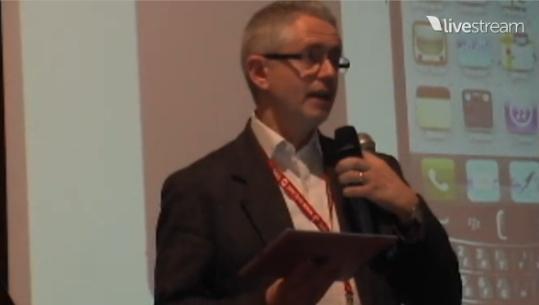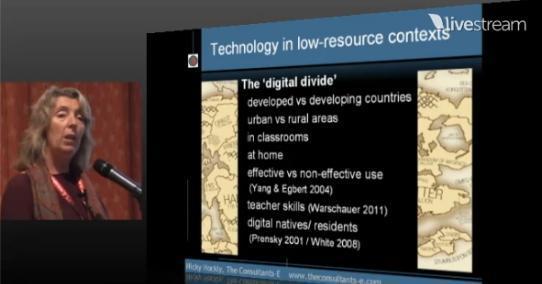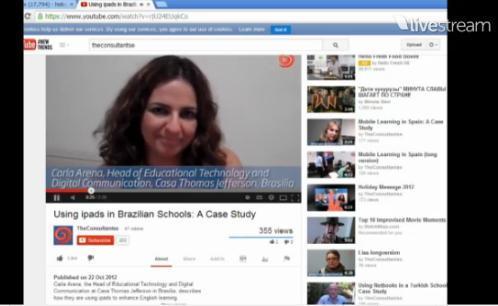|
I dashed down the platform for the Leeds train,
dragging my suitcase and laptop bag in a frantic rush to catch the train
that they said had already left. It was raining slightly above the
protective cover of the Manchester airport walkways. They know about
rain in England, all right.
I made it! Helpful hands hauled me aboard and I opened up my
Mac—to find there was no wifi! (Californians are so spoiled.) Oh well,
might as well enjoy the beautiful English countryside of backyard
gardens and then rolling green fields. “Oh, to be in England, now that
April’s there!”
Sent a text to Paul Sweeney, chair of LT SIG, and Nicky Hockly,
my hosts at the LT SIG Pre-conference Event, telling them to swap
Nicky’s and my presentation times because I was going to make it after
all. My plane out of Portland, where I was attending the TESOL
Convention, had been delayed for 5 hours because of mechanical problems
(a light wouldn’t go on or off), and Nicky and I drank coffee at the PDX
Bucky’s and commiserated. She got a flight out to London, but then had
to go back to Barcelona for her luggage—still arriving almost a day
earlier than I. There was just one flight from New York to Manchester
and it had left the following evening, hence the panicked run down the
platform. My day to catch up on time zones had been devoured by the
mechanics of the airlines.
In Harrogate, after another close connection in Leeds, I threw
my bags into a room at the hotel and marched over to a beautiful old
building where the PCE, Learning Technologies in Context, was held, with
just enough time to hear Nicky and then give my own presentation. We
later agreed it was a good thing, as our presentations meshed nicely,
hers looking at some of the pedagogical theory underpinning digital
literacy in high-, low-, and no-tech contexts, and mine describing, at a
somewhat more abstract level, the TESOL Technology Standards, which
also made reference to varied levels of technology access and the
framework for its use. A particular delight in Nicky’s talk was to see
Carla Arena’s smiling face talking in a short video about using iPads
with Brazilian students. Carla is a Webhead, CALL-IS member, and former
coordinator of the CALL-IS EVO. Nicky also gave a nice plug to Webheads,
who have been very active in our IS.
The afternoon was devoted to workshops, where I tried to induce
participants to write more vignettes for a potential online archive;
however, mostly they wanted to ask more questions about the Standards
and how the CALL-IS team developed them. Links to PCE-related videos,
discussions, and other documents can be found here.
After a meeting of the LT SIG steering committee (during which I
disgracefully almost fell asleep exhausted while taking notes on my
laptop), the gang took me out to dinner at a nearby Thai restaurant in
the absolutely charming town of Harrogate. Everything there was
thankfully in walking distance. In addition to Nicky and Paul, joint
coordinators of the SIG, I got to hang out with Heike Philp, online
events coordinator, and other luminaries of the SIG: Pete Sharma of the
steering committee; Sophia Mvridi, treasurer; Natalya Edleman,
newsletter editor; and Vicky Saumell, community manager.
Conference Differences
I noticed several interesting differences between TESOL
Portland, which I had just left (with the 12-hour hiatus in various
airports), and IATEFL Harrogate. For one, the distinction between
commercial and noncommercial just doesn’t exist for IATEFL. Because of
stringent rules on the foundation of 503(c)(3) organizations in the United
States, TESOL has to keep a careful separation between commercial
interests and education interests. At Harrogate, the publishers were in
almost too much evidence—lots of free receptions and parties, and all
kinds of support for delegates. Commercial signs everywhere, almost
overwhelming the senses.
Another strategic difference was the sheer amount of
technology. The Harrogate Center was built for technology-driven
conferences: good wifi reception everywhere and great presentation rooms
with multiple microphones and projection equipment. TESOL has to move
around over a large country annually, it’s an awkward size, and the
convention centers in second-tier cities are not always up to the
highest standards when it comes to technology, although we have seen
great improvement over the last several years.
The IATEFL conference also seems somehow more personal—not just
the difference in size (2,000 or so versus 8,000 or more for TESOL),
but there are whole days devoted to consecutive presentations by SIGs: a
business English day, a pronunciation day, an LT day. Yes, these are
overlapping, and of course there are far fewer presentations in a much
smaller space. While it is great to see far-flung online friends from
all over the world at TESOL, it often feels like the spaces and the
number of presentations are just overwhelming. Size matters in so many
ways.
Another of the personalizing aspects: Whole days of online
conference are devoted to interviewing personalities in the field.
Anyone can drop by online for an interesting chat with some of the best
people around. See the recordings here.
Our PCE was online also. Again, this was no doubt a function of
commercial support so that, although participants had to pay extra for
the PCE, it didn’t seem to matter that others could “listen in” online.
Of course, those present got the benefit of being there, hearing
everything, asking questions and getting immediate answers—well worth
the extra price, I hope. My presentation is at LiveStream and Nicky’s is here. All of the PCE
addresses can be found linked through these URLs, starting at 29:01
min.
High Points
For me, the most spectacular of the presentations was held in
the largest of the Center’s conference rooms. Gavin Dudney gave a
wonderful display of “E-Dreams”: a look at the future of technology for
teaching, followed by a brief discussion in small groups by participants
(something I hadn’t seen in “big” presentations at TESOL).
Unfortunately, while Gavin tried to be very neutral about “new” things,
like mobile technology and MOOCs, large portions of the audience seemed
downright hostile. This was a little surprising, and I wish I had had
more time—and nerve—to disagree with my group. I felt it might be in bad
taste or that I might have tomatoes thrown at my head. I suspect,
however, that a mixed audience at a large presentation like this at
TESOL might have had a similar response to the bewildering razzle-dazzle
of “the future.” In any event, the LT SIG does not fear or distrust
technology, and we are hoping to go forward with some joint projects
that will involve the Technology Standards.
By the third day at the conference, I was really beginning to
feel the effects of bad travel and what turned out to be viral
bronchitis, so sadly, I missed the LT SIG technology day and what was
apparently a very powerful presentation by Sugata Mitra on the future of
education. IATEFL has since followed up his talk with a webinar—a
practice I think TESOL might emulate. His and others’ presentations are
available at the IATEFL site.
I came away with some very warm feelings about the SIG people
and their approach, and I look forward to working on new projects with
them:We held a joint Virtual Round Table conference June 14, "Gaming and Gamification," and hope to have some kind of presence at BrazTESOL. The link to "VRT" is here.

Paul Sweeney introducing Nicky Hockly at IATEFL LT-SIG PCE,
Harrogate

Nicky Hockly at the IATEFL LT-SIG PCE, Harrogate

Carla Arena and the iPad project, as seen in Nicky Hockly’s PCE
presentation
Dr. Elizabeth Hanson-Smith has for the past 12 years
been part of the coordination team of the Electronic Village Online. As
well as teaching several online sessions, she has led development of
online modules to train moderators and guided mentoring efforts for this
free online education opportunity. She is currently consulting with the
U.S. Department of State and the University of Oregon in developing a
teacher training MOOC. She was also part of the team that created Trace
Effects, an online language learning game for international students.
She helped devise the interactive CD version of the Oxford
Picture Dictionary for adult learners and is pedagogical
consultant to the software company that produced Live Action English and
More Live Action English. Dr. Hanson-Smith founded and coordinated the
TESOL graduate program at California State University, Sacramento, and
has served as teacher trainer and curriculum developer in China, Sri
Lanka, Belize, Russia, and Egypt. Creator of six videos analyzing U.S.
culture through popular film, she has published regularly on issues in
language planning, the pedagogy of ESOL, language acquisition, computer-
and media-assisted language learning, and most recently technology
standards. She is co-editor of the popular CALL Environments:
Research, Practice, and Critical Issues and co-author of
TESOL's Technology Standards.
|

